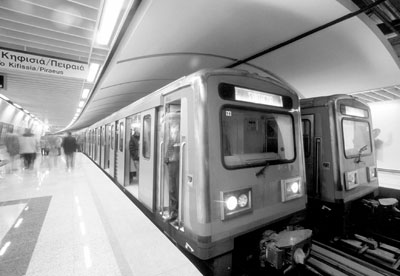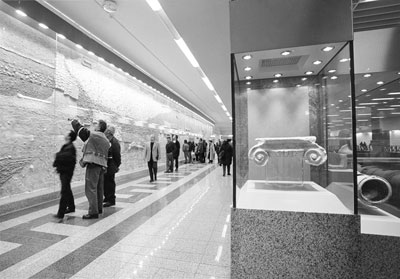Olympic transportation
by Jay Brunhouse
When the best of the world’s runners, swimmers, gymnasts and achievers in 44 sports ranging from Archery to Wrestling (Freestyle Women) eagerly march, bearing the colors of the national flags of the countries of the world, to the Athens Olympic Stadium for the opening ceremony on Aug. 13, 2004, most will have arrived at the new Athens International Airport and traveled Athens’ new metro line from the airport to the center of the Greek capital.
Visitors riding the new trains from Athens’ International Airport will appreciate the gargantuan improvements in the infrastructure that the 2004 Athens Games brought.
Traffic engineers arranged for all spectators, Olympic personnel and volunteers to use public transportation, including new metro, new suburban rail, new light rail and spacious highways, to travel to and from the Olympic venues scattered throughout Attica (and to Thessalonica [Salonika] for football (soccer).
In 2004, they opened five miles of new metro lines, a 15-mile streetcar network and a 20-mile suburban railroad reaching the new international airport. All will remain for visitors and residents after the Games are completed.
Metro
Athens’ metro system, which opened with much fanfare on Jan. 28, 2000, is an ultramodern, $2.5 billion network, now with three lines, new stations, new rolling stock and the latest technology. The largest, most complex project ever undertaken in Greece, the new metro changed getting around Athens into a remarkably convenient and pleasant experience. While it previously took visitors one hour from point to point in horrendous peak traffic, it now takes nine minutes.
The graffiti-free, 6-carriage trains run every three minutes at rush hours and five to 10 minutes apart at nonpeak hours. Car floors are level with platforms. Special lighting and signs in Greek and Roman letters make getting around easy. Exits have up escalators, but carrying luggage down long stairways can be a struggle. Elevators solve this problem.
During construction, archaeologists took care to remove all significant finds and avoid damage to existing monuments. They directed tunnel-boring machines to pierce 7.5 miles of solid rock to avoid cultural treasures, and they supervised underground tunneling techniques, in preference to surface excavation, at several stations near already known archaeological sites.
The Constitution (Syntagma) Square metro station, hub of the system, is like a mini-museum. Photos and replicas of the archaeological artifacts uncovered during the construction shine in display cases. Commissioned artwork brightens many more stations.
Athens’ new red and blue lines added more than 12 miles and 20 new stations to the existing green line that runs between the port of Piraeus in southwest Athens to Kifissia in the northeast.
The east-west blue line connects Monastiraki in Plaka, Athens’ popular Old Town, to Ethniki Amyna, where the $375 million extension provides easy access to the 2001 Athens International Airport aboard seven 6-carriage, dual-voltage, 75-mph metro trains. The 19-mile line includes six miles within Athens’ city limits as well as the newly built section to the airport. The trains have only 185 seats because some of the floor space is used for luggage, and, most important, they are air-conditioned against the typically unbearable Athens summers.
Greece by train
Considering that Greece is a country with a population of just 10.5 million and that almost half live in greater Athens and two million live in Thessalonica, it won’t surprise anyone that the Greek Railroad (OSE; website in Greek) has one of the sparsest networks of any European country.
A 550-mile-long meter-gauge line circles the Peloponnesian Peninsula through the port of Patras while the 970-mile-long standard-gauge northern network connects Athens to Thessalonica and supports trains to the Balkans and Central Europe.
Traveling with a top-speed capability of 100 mph (which set speed records in Greece), OSE’s flagship InterCity trains between Athens and Thessalonica again set speed records in 2004, cutting nearly two hours from the old travel time. They now take four hours, 30 minutes, averaging 71 mph over the 318 miles.
When you go
Metro tickets cost €0.70 (near 83¢) per ride. A day card for metro and buses costs €2.90 ($3.45).
Eurailpasses, Balkan Flexipasses, Greek Railpasses and Eurail Select Passes that also include Italy are valid throughout Greece. Reduced rates are given to cash-on-the-spot travelers under 26 and foreign students presenting an I.D. card.
Greece is a magnet to Eurail product holders with validity in Greece because of the bonus that gives them free deck-class ferry transportation from Italy and a possible carefree stopover on Corfu’s beaches. They get free passage between Brindisi, Italy, and Patras, Igoumenitsa or Corfu, Greece, aboard the Greek Hellenic Mediterranean Lines (HML) and Blue Star ferries. Also, the large, white Superfast Ferries of Attika Superfast (website in German), a German company, offer them free passage between Ancona and Bari to Igoumenitsa and Patras. Passengers pay a €20 ($24) surcharge during July and August for all sailings.
In addition, passengers must pay port taxes in euros. Sleeping accommodations such as cabins or airline-type seats cost extra. Before boarding, passengers must check in at the shipping line’s office at the pier. When they receive their ferry ticket, they must tell the ticket agents whether they wish a stopover in Corfu or Igoumenitsa. When they ticket only to Corfu, they cannot change their mind and continue to Patras.
For more information, contact the Greek National Tourist Organization, Olympic Tower, 645 Fifth Ave., Ste. 903, New York, NY 10022; phone 212/421-5777. Another good website is www.athensguide.org.
In July, we’ll ride Belgium’s newest high-speed line between Brussels and Liege. All Aboard! Till next month.




